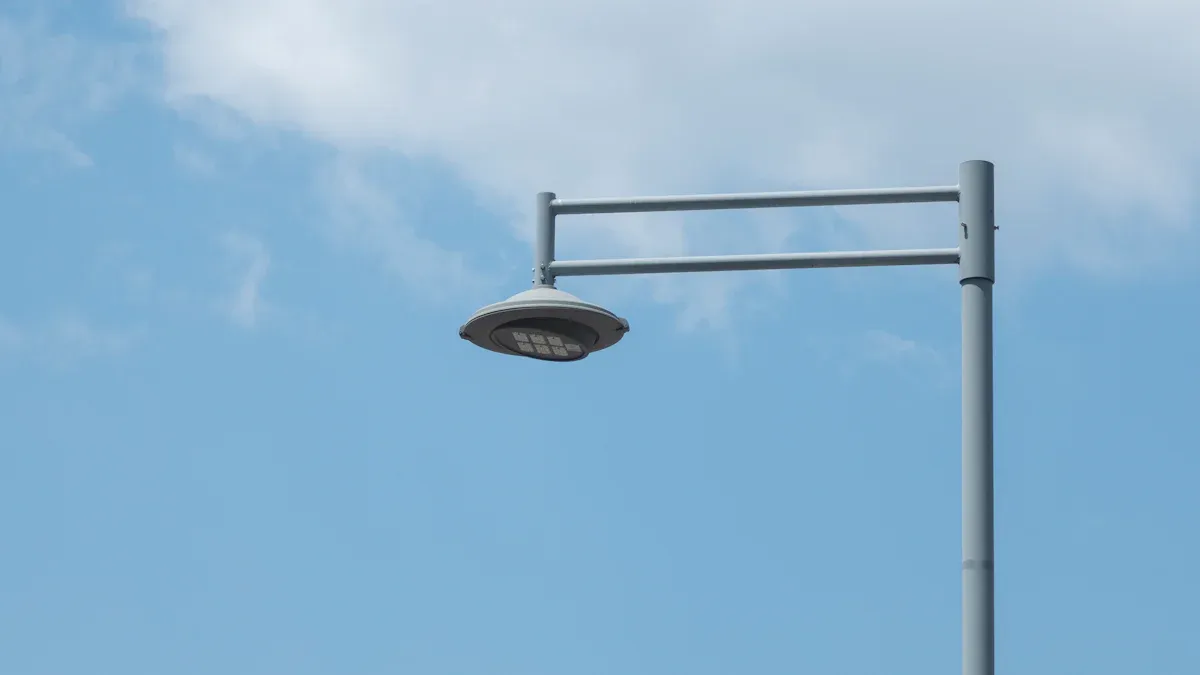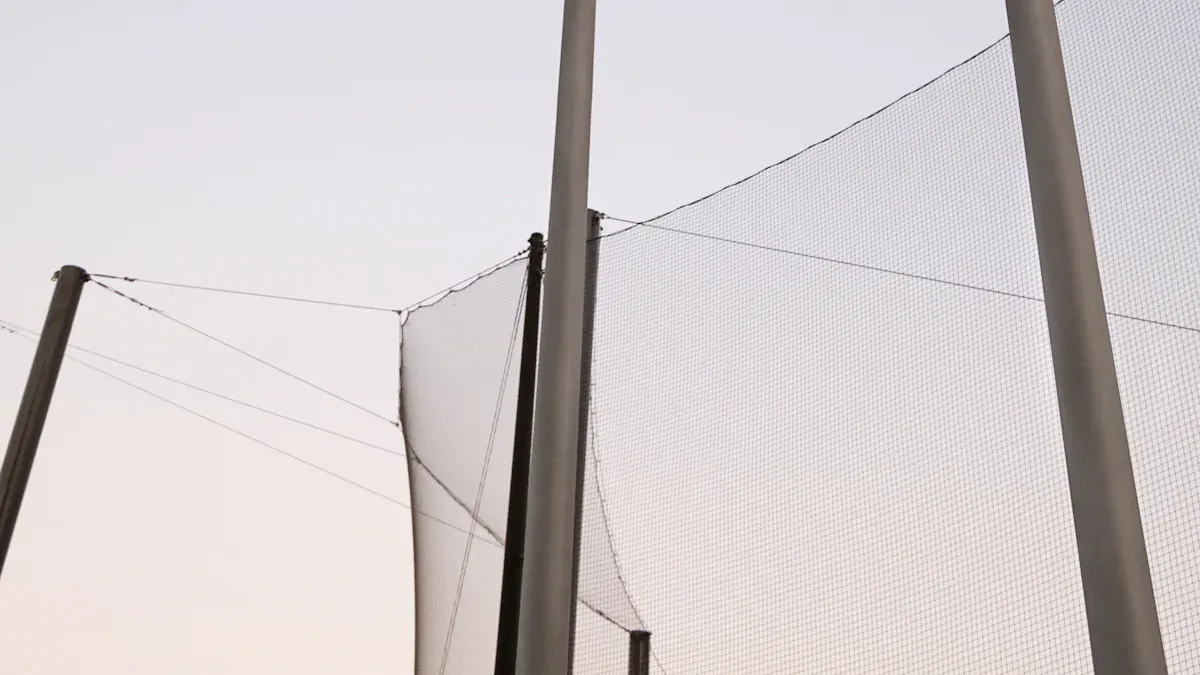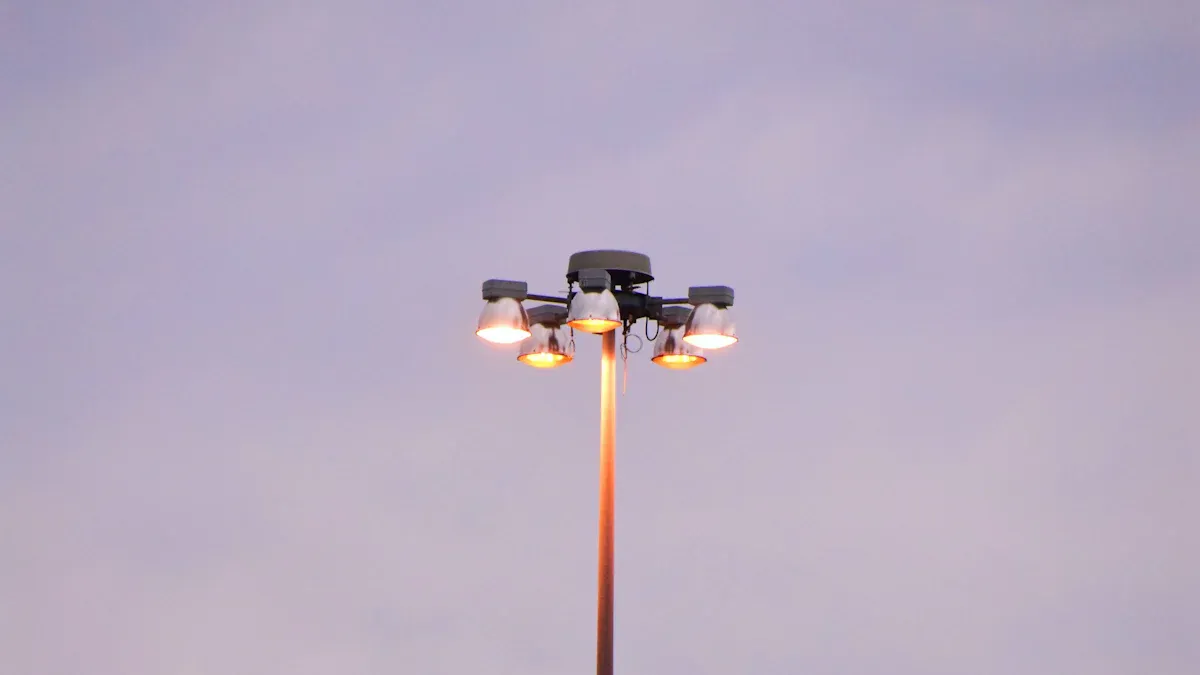Choosing the Right LED Street Light Pole: Materials, Heights, and Installation Considerations

Choosing the right LED street light pole is crucial. It enhances the appearance of streets and ensures safety with effective lighting, including options like solar light. A quality product not only improves the performance of LED lights but also has a longer lifespan, which saves both time and money. Whether for parks, highways, or neighborhoods, selecting the appropriate pole ensures that lights function optimally and complement the environment.
Key Takeaways
Pick the right material for street light poles. Think about your budget and weather. Steel is cheap but can rust. Aluminum lasts long and doesn’t rust. Composite poles work well in bad weather.
Choose the right pole height for safe and bright lighting. Look at traffic speed, how busy the area is, and its design.
Install poles with strong bases to keep them steady. Check the soil and follow steps to stop tilting or breaking.
Take care of street light poles often to keep them working. Look for damage, clean the lights, and fix broken parts to save money.
Make sure poles are easy to reach for repairs. This makes fixing faster and safer, keeping lights working well.
Materials for LED Street Light Poles

Picking the right material for an LED street light pole is important. It affects how strong, affordable, and suitable the pole is for different places. Below is a simple guide to the common materials used.
Steel Poles
Steel poles are strong and not too expensive. They can hold heavy lights and handle a lot of pressure. But steel can rust, especially in wet or coastal areas. To make them last longer, you might need to spend on upkeep or special coatings.
If you don’t have much money to spend and the area is dry, steel poles could work. But for saving money over time, other materials might be better.
Aluminum Poles
Aluminum poles are light but still strong. They don’t rust easily, so they’re great for rainy or humid places. Being lightweight also makes them easier to move and set up, which saves on labor costs.
Even though aluminum poles cost more at first, they don’t need much care later. This makes them a smart choice if you want something durable and affordable.
Composite Poles
Composite poles are made from materials like fiberglass or carbon fiber. They are light, don’t rust, and last a long time. These poles are perfect for tough weather where other materials might not work.
One big benefit of composite poles is that they can handle strong winds and heavy snow. While they cost more upfront, their long life and low upkeep can make up for the price.
Comparing Material Strength, Durability, and Cost
Here’s a simple table to compare the materials for LED street light poles:
Material Type | Best For | Cost Details |
|---|---|---|
Stainless Steel | Tough weather; doesn’t rust | Costs more at first but needs little care later |
Aluminum Alloy | Wet or rainy areas | Medium price; easy to install and maintain |
Steel | Dry areas; low budget | Cheap at first but costs more to maintain in bad weather |
When choosing a material, think about the weather where the pole will be and how much you can spend now and later. This way, your LED street light pole will last and work well for years.
Comparing Material Strength, Durability, and Cost
When picking a material for an LED Street Light Pole, think about strength, durability, and cost. Each material—steel, aluminum, and fiberglass—has its own pros and cons. Knowing these differences helps you choose the best option.
Strength
Strength shows how much weight a pole can hold. Steel poles are the strongest and work well for heavy lights or windy areas. Aluminum poles are strong enough for most cities and towns. Fiberglass poles are also strong but can’t hold very heavy lights.
Durability
Durability is about how long a pole lasts in different weather. Steel poles last 15 to 30 years but can rust in wet places. Aluminum poles don’t rust and can last over 50 years with little care. Fiberglass poles resist rust too but may wear out in strong sunlight, lasting 15 to 20 years.
Cost
Cost is important when choosing a pole. Steel poles are cheap at first but need more care later because of rust. Aluminum poles cost more upfront but save money over time since they need less upkeep. Fiberglass poles cost in the middle range but may need special disposal, which adds to the price.
Here’s a simple comparison of the materials:
Material | Strength | Durability | Cost |
|---|---|---|---|
Steel | High | 15 to 30 years | Low |
Aluminum | Moderate | 50+ years | High |
Fiberglass | Moderate | 15 to 20 years | Moderate |
Pros and Cons of Each Material
Here’s a quick look at the good and bad sides of each material:
Steel Poles:
Pros: Very strong, low starting cost, easy to install.
Cons: Rusts easily, heavy, needs more care.
Aluminum Poles:
Pros: Light, doesn’t rust, lasts long, needs little care.
Cons: Costs more at first, not as strong as steel.
Fiberglass Poles:
Pros: Light, simple to set up, resists rust.
Cons: Can get damaged by sunlight, shorter life, costly to dispose of.
By thinking about these points, you can pick the right pole for your budget, weather, and lighting needs. A good LED Street Light Pole will last long and save money over time.
Determining the Right Height for LED Street Light Poles

Picking the correct height for an LED Street Light Pole is very important. It helps light spread well, keeps areas safe, and matches the surroundings. Let’s look at what affects pole height, common standards, and how to balance looks with function.
Factors Influencing Pole Height
Many things decide how tall a street light pole should be. These factors make sure the lighting is safe, clear, and fits the area. Key points to think about include:
Design speed: Faster cars need taller poles for better lighting.
Traffic volume: Busy roads need taller poles to light bigger areas.
Traffic composition: Heavy vehicles need higher poles to reduce glare.
Separation of carriageway: Wide roads need tall poles to light both sides.
Junction density: Intersections need poles of different heights to avoid shadows.
Parked vehicles: Tall poles light areas blocked by parked cars.
Ambient luminance: Bright cities may need shorter poles to prevent over-lighting.
Navigational task: Poles must be high enough to guide people safely.
By thinking about these, you can pick a height that works best for safety and lighting.
Typical Height Standards for Different Applications
The height of LED street light poles changes based on the area they serve. General rules help choose the right height for public spaces. Here’s a simple guide:
Area Type | |
|---|---|
Streets | 15 to 50 feet |
Parks | Shorter for paths, taller for sports fields |
Commercial Areas | Shorter for walkways, taller for parking lots |
For streets, taller poles cover more space. In parks, short poles make paths cozy, while tall ones light big areas like sports fields. Commercial spots need mixed heights for paths and parking.
Balancing Lighting Needs and Aesthetic Integration
Pole height should also look good in the area. A good height balances lighting needs with how it fits the surroundings. For example, in neighborhoods, shorter poles look better and avoid too much brightness. In cities with tall buildings, taller poles match the area’s size.
Think about energy use too. Taller poles might need stronger lights, using more power. Shorter poles may need more of them to light the same space. Finding the right balance makes lighting effective and nice to look at.
By checking all these points, you can choose a pole height that improves safety, saves energy, and looks great.
Installation Considerations for LED Street Light Poles
Foundation Design and Stability
A strong base keeps the street light pole safe and steady. To do this, think about the soil, weather, and how it’s installed. For example, loose or sandy soil needs deeper bases to stop tilting. Coastal areas need rust-proof materials and stronger bases for bad weather.
Steps for a solid foundation:
Check the site to see if the ground is stable.
Make the base deeper if the soil is weak.
Dig the ground and secure the anchor bolts tightly.
Pour concrete and let it dry fully before setting up.
Good planning and work will make the pole last longer and stay strong.
Wiring and Electrical Connections
Good wiring helps the street light work well and safely. Rules like ANSI C136 make sure wires are safe and fit together. For instance, ANSI C136.10 uses three pins for controls, and ANSI C136.41 adds pins for dimming. These rules make lights work better with other systems.
Tips for wiring:
Use NEMA connectors for safe and easy connections.
Ground wires properly to avoid electrical problems.
Test all wires before turning on the lights.
Following these steps will keep the lights working safely for a long time.
Environmental and Wind Load Considerations
Weather, like strong winds, affects how poles are built and installed. High winds can push on poles and cause damage. To plan for this, calculate wind pressure using this formula:Wind Load = Pressure Coefficient × Surface Area × Wind Speed²
Other things to check:
The drag coefficient, which depends on the pole’s shape.
The front area of the pole, which shows how much wind hits it.
AASHTO rules, which help figure out wind pressure and pole strength.
By thinking about these, your street light pole will stay strong and work well, even in tough weather.
Maintenance and Accessibility Planning
Taking care of your LED street light poles keeps them safe and working well. Ignoring maintenance can cause expensive fixes, poor lighting, and safety risks. A good plan helps keep your lights in great shape.
Regular Maintenance Practices
Checking your poles often is very important. Here are some simple steps:
Look for cracks or damage on poles and fixtures.
Change broken LEDs quickly to keep lighting steady.
Wipe lenses and fixtures to clear dirt or dust.
Watch how lights work and replace them when needed.
These actions make the area safer and save money by avoiding big repairs.
Tip: Keep a record of checks and fixes. This helps you stay on track and not miss anything.
Accessibility Planning for Repairs
Making poles easy to reach helps with quick repairs. Hard-to-reach poles take more time and cost more to fix. To avoid this, try these ideas:
Place poles where repair trucks can easily get to them.
Use poles with parts that are easy to swap out.
Label wires clearly to make fixing problems faster.
Good planning means repairs are done faster and with less trouble.
Long-Term Benefits of Proactive Planning
Planning ahead saves time and money. Regular checks stop small problems from getting worse. Easy-to-reach poles make repairs quicker and safer for workers. A well-kept system gives steady lighting and keeps everyone safe.
Note: Spending on maintenance now can make your poles last longer and cost less over time.
By following these tips, your lighting system will stay safe, work well, and save money for many years.
Picking the right LED street light pole keeps areas safe and bright. Materials like aluminum, steel, or fiberglass should be strong and long-lasting. The pole’s height needs to fit the area’s lighting needs and look good too. Installing poles correctly, following local rules and wind-load limits, helps them stay steady and last longer.
Following local and national rules is very important when setting up LED street lights. These rules cover things like how bright the lights are, their energy use, and how they affect animals.
To get the best results:
Talk to experts to follow local building rules.
Choose strong poles that hold LED lights well.
Plan regular checks to keep poles in good shape.
By focusing on these points, you’ll have lighting that works well, lasts long, and looks nice.
FAQ
What is the best material for LED street light poles?
The best material depends on what you need. Steel is strong and affordable. Aluminum doesn’t rust and lasts longer. Composite poles work in bad weather but cost more. Pick based on your budget, weather, and upkeep needs.
How do I determine the right height for a street light pole?
Think about the area’s purpose. Highways need tall poles (30-50 feet) for wide lighting. Parks or paths need shorter poles for focused light. Choose a height that keeps the area safe and looks good.
What factors affect the installation of street light poles?
Important factors are soil, wind, and wiring. Weak soil needs deeper bases. Windy places need stronger poles. Good wiring keeps lights safe and working well. Plan ahead to avoid problems later.
How often should I maintain LED street light poles?
Check poles every 6 to 12 months. Look for cracks, rust, or wiring issues. Clean lenses and fix broken parts quickly. Regular care keeps poles safe, saves money, and makes them last longer.
Can LED street light poles withstand extreme weather?
Yes, if you pick the right type. Composite poles handle tough weather. Aluminum poles don’t rust in wet areas. Make sure the base and pole strength match local weather rules.
Tip: Always ask experts to ensure your poles are safe and durable.
See Also
Selecting Ideal LED Street Lights for Community Initiatives
Comprehensive Overview of LED Area Lights and Their Uses
Exploring Outdoor LED Lighting: Varieties, Advantages, and Setup Advice
Advantages and Maintenance of LED Lighting for Parking Lots
Understanding LED Street Light Technology and Its Advantages

